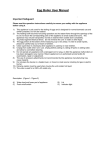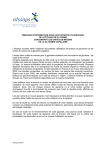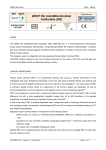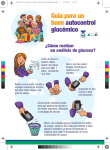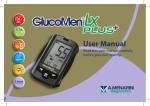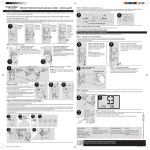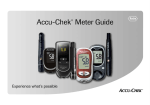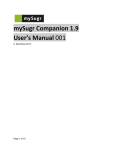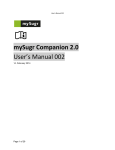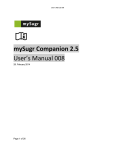Download Blood Glucose Testing
Transcript
Blood glucose testing & insulin injecting techniques blood glucose testing & insulin injecting techniques i www.glucomen.co.uk Finger Pricking 1 How to finger prick painlessly Anyone who regularly needs to check their blood glucose and blood ketone levels will agree that they want to get their blood samples without pain and discomfort. Age, gender and profession will all have an affect on how you prick your finger and any discomfort you may or may not feel, but there are steps you can follow which can improve your experience of this procedure. If you are a man who works with his hands and has thick skin, your finger pricker settings and needle type may need to be different from a woman of advanced age or a young child with small fingers. There are a number of things to consider when you begin to test. Its all about the system Check your blood glucose meter; less blood = easier testing The first thing to consider when blood glucose and blood ketone monitoring is what meter system to use. There have been great improvements in systems over recent years but if you are using an older style meter that needs a lot of blood (over 1.0µl of blood for instance) you may still need to use a lancet that is quite thick to get enough blood from your finger. Newer blood glucose and blood ketone meters work with very small amounts of blood (only around 0.3µl of blood) allowing you to use a very thin lancet to prick your finger. A thinner needle will give less discomfort than a thicker one. If you have a meter which is 2-3 years old, it is very simple to upgrade to a newer system. Simply ask your nurse, pharmacist or doctor for information on current systems available from us, or see the back of this leaflet. Here are other hints & tips to help towards pain–free testing. www.glucomen.co.uk Finger Pricking 2 Find the lancet and pricking device that’s right for you Once you have a meter that works with small blood samples, it is important to use the right needle and lancing device. It can be confusing knowing which one is best, but in general you want to use the thinnest needle you can to get a sufficient blood sample. Needle size is shown in gauge or millimetres – the higher the gauge number the thinner the needle eg. 30G = .315mm thick whereas 28G = 0.5mm thick. Once you have your lancet, you also need a great finger pricker (lancing device). Choosing one that has multiple depth penetration options, allows you to change how deep the needle goes into your skin. Skin thickness and how well your fingers bleed will affect the settings you use. A finger pricker which has force adjustment also offers another advantage as it lets you vary the needle thrust if one of your fingers has tough callus skin. Now you have your system. Before you go pricking Know where to prick You have 5 digits on each hand for testing, and although you could use all of them most people prefer to not use their index fingers and thumbs, to ensure they don’t become sore as they are used a lot in daily life. To reduce trauma to your fingers, remember to change the digit you use each time you test and use both hands, this is called “rotating sites”. Check your meter user manual to see if you can use “alternative sites” for testing such as the base of your thumb - ask your diabetes team which areas are best for you. Finger Pricking 3 It is important you test the correct area on your finger. Prick near the tip of the finger (above the knuckle) slightly to the side. Do not test on the pads of your finger, the tip or near the nail bed, these can be very painful and you may feel discomfort when you later try to pick something up. So remember, always use the side of the finger never right in the middle. Once you have chosen your system try these tips to help you achieve the sample you need without any discomfort. Keep your hand warm Warming your hand will improve circulation. Rubbing the pricking area or washing in warm water will help. Remember to wash your hands with plain soap before and after you test to keep from getting infections and to remove contamination. If you prick your finger with your fingertip pointing up the blood will have to travel up to come out. By pointing your finger down the blood will be able to come out easier. So test with your finger tips pointing down & below your heart. Gently squeeze (milk) your fingertip If enough blood has not come out, try gently milking the finger to help the blood come out. If still no blood, do another finger tip prick as the blood may have already clotted stopping the bleed, but remember to change to a new lancets before re-attempting. In summary: n Rotate the site every time you test. Changing the site for each test gives time for the previous area used to heal and avoids calluses forming. n Use a blood glucose and blood ketone meter that works with a tiny amount of blood as less blood needed means less tissue trauma, therefore less discomfort. n Use a lancing device with depth & force adjustment so you can adjust the system to your skin type. Personalising your devices allows you to achieve the correct blood sample each time, first time. n Use very thin lancets as they cause fewer traumas to skin tissue, offering more comfort. How to inject insulin Giving or receiving insulin injections becomes part of the daily diabetes routine, but the correct technique is vital to ensure your insulin is absorbed correctly and to ensure the procedure is as comfortable as possible. The layers under the skin surface are the dermis, then the subcutaneous tissue and then the muscle layer. It is important that insulin is injected into the subcutaneous tissue to ensure that the insulin is reliably absorbed and that it is not injected into muscle as this is more painful and can cause the insulin to be absorbed more quickly, leading to hypos. Use the correct insulin injection site The abdomen (tummy) is the most common site for injecting insulin, however other areas can be used if this is not suitable for you. Other sites can be used, including the upper arms, upper buttocks and the outside of the thigh. These sites are most effective because they have a layer of fat to absorb the insulin better, have fewer nerve endings and are the most comfortable places to use. You should discuss with your healthcare team which sites are best for you. The insulin you use may also affect which area is best for you as insulin can be absorbed differently through the various injection sites. Some sites are better for rapid absorption (abdomen), whereas others are better for slow absorption (thigh). Of equal importance in the effort to gain optimum blood glucose control is the rotating of the insulin injection sites. This means varying the area used within each site and leaving a gap of an inch or more between the site of injections. DO NOT KEEP INJECTING INTO THE SAME SPOT www.glucomen.co.uk Insulin injections 1 Insulin injections 2 Rotating sites – lumps and bumps Failure to rotate insulin injection sites is an extremely common cause of poor blood glucose control and can also cause “lumpy” areas to form. Continuing to inject there will usually result in slower and erratic absorption of the insulin. This can cause variable blood glucose readings. If lumpy areas form they can take at least 6-8 weeks to go away, so it is a good idea to check for “lumpy” injection sites regularly, as they may not necessarily be visible. If you are unsure how to do this ask a diabetes nurse specialist or a doctor in your diabetes team. Pinching up If you have a plentiful layer of fat, stretch the skin slightly before injecting and you may not need to “pinch up”, however thin built people with little fat should lift up a fold of skin and inject the insulin into it. Ask your diabetes team which needle length is best for you and if you need to “pinch up”. If you are thin you must ensure that the insulin is being administered into subcutaneous tissue, so it is essential to use a gentle “pinch up” technique. This should be done using only the thumb and index finger so that muscle is not drawn up into the fold. Insulin should be injected straight into the skin at 90° A subcutaneous injection into the fatty layer of tissue under the skin Here are other hints & tips to help towards good insulin injection technique Be careful when injecting into the thighs Exercise will speed up the absorption of insulin. Change the insulin needle each time you inject This is important and may make injections less painful in addition to preventing leakage of insulin from the cartridge. If there is leakage from a cartridge of mixed insulins The proportions of insulins will be affected so use a new cartridge. “Cloudy” insulin must be re-suspended It is important to ensure that the “cloudy” insulin in your pen device is correctly re-suspended to ensure the proportions of insulin are correct. Slowly turning the pen upside down 10 - 15 times should achieve re-suspension of the insulin. Check your pen needle length Ask your diabetes team which length insulin pen needle is best for you. In summary: n Only inject into your subcutaneous skin layer. n A sk your diabetes team which needle length is best for you and if you need to “pinch up”. n R emember to “rotate” your injection area and leave over an inch between sites. n Insulin is more rapidly absorbed from the abdomen. n C heck regularly for lumpy areas, and if you find any discuss them with your diabetes team. www.glucomen.co.uk Insulin injections 3 Visit www.glucomen.co.uk Video Tutorial – Testing Essentials People with Diabetes trust Online Support The only meter you’ll ever need... Coloured covers for style – style the meters with the most colours ever! Aqua Black Blue Green Pink Purple Red White Helpline For information on diabetes products and services from GlucoMen, contact: UK: 0800 243 667 Republic of Ireland: 1800 709903 Northern Ireland: 0800 7837286 Email: [email protected] www.glucomen.co.uk Just search GlucoMen on facebook Menarini Diagnostics Wharfedale Road, Winnersh, Wokingham, Berkshire, RG41 5RA LX12001








